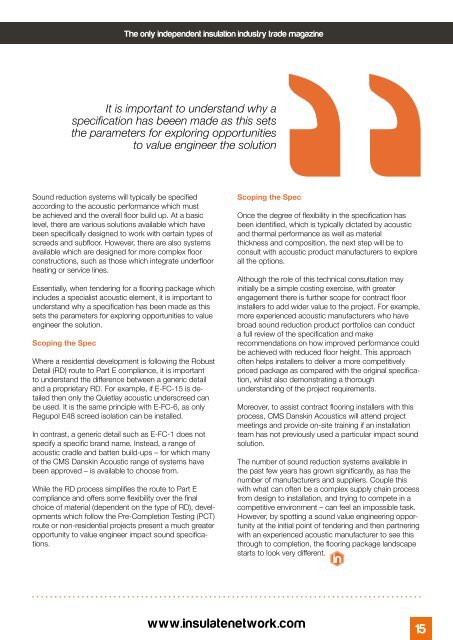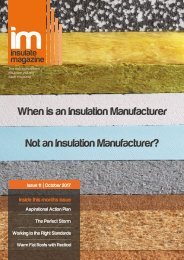Insulate Magazine Issue 15
Insulate Magazine featuring exclusive insulatIon articles and competitions from Mauer, BBA, NIA, 3M, and more. Essential construction industry resource
Insulate Magazine featuring exclusive insulatIon articles and competitions from Mauer, BBA, NIA, 3M, and more. Essential construction industry resource
Create successful ePaper yourself
Turn your PDF publications into a flip-book with our unique Google optimized e-Paper software.
The only independent insulation industry trade magazine<br />
It is important to understand why a<br />
specification has beeen made as this sets<br />
the parameters for exploring opportunities<br />
to value engineer the solution<br />
Sound reduction systems will typically be specified<br />
according to the acoustic performance which must<br />
be achieved and the overall floor build up. At a basic<br />
level, there are various solutions available which have<br />
been specifically designed to work with certain types of<br />
screeds and subfloor. However, there are also systems<br />
available which are designed for more complex floor<br />
constructions, such as those which integrate underfloor<br />
heating or service lines.<br />
Essentially, when tendering for a flooring package which<br />
includes a specialist acoustic element, it is important to<br />
understand why a specification has been made as this<br />
sets the parameters for exploring opportunities to value<br />
engineer the solution.<br />
Scoping the Spec<br />
Where a residential development is following the Robust<br />
Detail (RD) route to Part E compliance, it is important<br />
to understand the difference between a generic detail<br />
and a proprietary RD. For example, if E-FC-<strong>15</strong> is detailed<br />
then only the Quietlay acoustic underscreed can<br />
be used. It is the same principle with E-FC-6, as only<br />
Regupol E48 screed isolation can be installed.<br />
In contrast, a generic detail such as E-FC-1 does not<br />
specify a specific brand name. Instead, a range of<br />
acoustic cradle and batten build-ups – for which many<br />
of the CMS Danskin Acoustic range of systems have<br />
been approved – is available to choose from.<br />
While the RD process simplifies the route to Part E<br />
compliance and offers some flexibility over the final<br />
choice of material (dependent on the type of RD), developments<br />
which follow the Pre-Completion Testing (PCT)<br />
route or non-residential projects present a much greater<br />
opportunity to value engineer impact sound specifications.<br />
Scoping the Spec<br />
Once the degree of flexibility in the specification has<br />
been identified, which is typically dictated by acoustic<br />
and thermal performance as well as material<br />
thickness and composition, the next step will be to<br />
consult with acoustic product manufacturers to explore<br />
all the options.<br />
Although the role of this technical consultation may<br />
initially be a simple costing exercise, with greater<br />
engagement there is further scope for contract floor<br />
installers to add wider value to the project. For example,<br />
more experienced acoustic manufacturers who have<br />
broad sound reduction product portfolios can conduct<br />
a full review of the specification and make<br />
recommendations on how improved performance could<br />
be achieved with reduced floor height. This approach<br />
often helps installers to deliver a more competitively<br />
priced package as compared with the original specification,<br />
whilst also demonstrating a thorough<br />
understanding of the project requirements.<br />
Moreover, to assist contract flooring installers with this<br />
process, CMS Danskin Acoustics will attend project<br />
meetings and provide on-site training if an installation<br />
team has not previously used a particular impact sound<br />
solution.<br />
The number of sound reduction systems available in<br />
the past few years has grown significantly, as has the<br />
number of manufacturers and suppliers. Couple this<br />
with what can often be a complex supply chain process<br />
from design to installation, and trying to compete in a<br />
competitive environment – can feel an impossible task.<br />
However, by spotting a sound value engineering opportunity<br />
at the initial point of tendering and then partnering<br />
with an experienced acoustic manufacturer to see this<br />
through to completion, the flooring package landscape<br />
starts to look very different.<br />
www.insulatenetwork.com<br />
<strong>15</strong>













